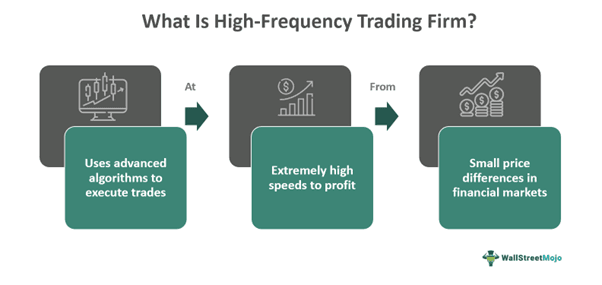Table of Contents
What Is A High-Frequency Trading (HFT) Firm?
A high-frequency trading (HFT) firm refers to a financial organization using highly advanced algorithms and technology to implement a massive quantity of trades at ultra-high speeds. They use complicated and proprietary tools to analyze markets, find trends, and execute superfast trades in the shortest time to achieve short-term gains.

Their HFT strategies comprise statistical arbitrage, market making, and arbitrage. These firms utilize HFT to capitalize on the most minor price differences in the market. It can add to the volatility of the market and pose an unfair advantage to more prominent firms over smaller investors.
Key Takeaways
- High-frequency trading (HFT) firms pertain to financial institutions utilizing profoundly sophisticated algorithms and software to carry out gigantic amounts of trade exchanges at ultra-high paces.
- They utilize advanced and in-house tools to segregate business sectors, track down patterns, and execute super-fast trade exchanges quickly to accomplish short-term.
- It increases liquidity, analyzes data, reduces costs, enhances efficiency, pushes companies towards new technologies, deploys unique HFT algorithms, and is regulated by authorities for fair trading practices.
- They use sophisticated algorithms, heavy technology, automated strategies, high-frequency order flow, and proprietary algorithms and adapt to evolving market and regulatory environments.
High-Frequency Trading Firm Explained
A High-Frequency Trading Firm operates on the premise of efficiency and speed to capitalize on the minor price difference in the market to extract profits. These firms employ the most sophisticated and super-powerful computers with extraordinary speed, co-located data servers, and real-time data sources to decrease latency and optimize profits. It works by executing a large number of trades at milli or micro-seconds to exploit any possible price discrepancies present across multiple exchanges or locate short-term trends.
It has multiple implications, such as increasing market liquidity, tightening bid-ask spreads, and promoting efficient price discovery. Nevertheless, critics have warned of the lack of fairness and bias of the system towards slower investors and its consequential amplification of market volatility.
They cater primarily to institutional investors seeking very high-frequency execution and algorithmic trading abilities. It has been impacting market dynamics through its dominance and raising concerns about its regulations.
Many traders use Saxo Bank International to research and invest in stocks across different markets. Its features like SAXO Stocks offer access to a wide range of global equities for investors.
Features
Every HFT has some inbuilt features, as listed below:
- They all depend on huge, complex computer software with sophisticated algorithms to analyze massive data at lightning speed.
- They invest excessively and humongous in super heavy cutting-edge and innovative technology.
- These target market inefficiencies and make profits from the lowest possible price difference by trading high volume at short-term positions, leading to small cumulated profits that become huge at the end.
- All strategies become automated, fully performing trades as per pre-defined parameters.
- They generate massive order volume, having continuous exit and entry positions.
- Their high-frequency order flow has significant impacts on market liquidity and market price trends.
- These firms have proprietary confidential algorithms for trading to gain a competitive edge over others.
- They have the in-built tendency to modify their strategies per evolving market situations and regulatory environment.
Examples
Let us use a few examples to understand the topic.
Example #1
Better Hand Financial Technologies (BHFT), a high-frequency trading firm based in Dubai that embraces a remote work culture, has been quietly expanding and attracting talent from significant competitors. BHFT hired Ilya Malinovsky as CTO and Ruslan Rezhepov as head of trading, with Brook Teeter joining as global head of business development last month. Despite claiming over 100 employees, fewer are visible on social media, and the firm's founder remains undisclosed. Launched in late 2021, BHFT has shown interest in hiring sports champions and uses Rust over industry-standard C++. Employee reviews highlight a friendly, multicultural team and a modern tech stack, though opinions on remote work vary. BHFT is currently hiring for nine remote-first roles, including senior quant traders and a site reliability engineer, for a two-month internship.
Example #2
Let's assume that a high-frequency trading organization, Tetra Pvt. Ltd., is a specialist in the Bitcoin market at the Old York Stock Exchange (OYSE). Tetra's state-of-the-art algorithms constantly check for price discrepancies across the OYSE. If Tetra detects Bitcoin's price is slightly higher on one exchange booth than some other, it can leverage it the most in milliseconds. Tetra might initiate a purchase order at a decreased price and a simultaneous sell order at a higher price, cashing in on the tiny rate difference.
By executing a large volume of these trades at breakneck speeds (supposedly hundreds of thousands in keeping with second), Tetra's objective is to collect smaller gains that sum up appreciably because of the sheer large variety of transactions. This approach requires ultra-powered computer systems and complicated algorithms to assess markets, pick out opportunities, and implement trades at lightning speed.
Disclosure: This article contains affiliate links. If you sign up through these links, we may earn a small commission at no extra cost to you.
Importance
They have played a vital role in modern share markets by offering several benefits:
- They buy and sell regularly, contributing a considerable volume of trade to the market, increasing the liquidity to promote smoother market working.
- They have the power to analyze a gazillion amount of data to find and take advantage of the slightest price differences.
- It reduces transaction costs for small traders by tightening the differences between sell and buy price or bid-ask spreads.
- It enhances market efficiency by incorporating any event or news instantly into the market trading and prices.
- It has pushed companies towards bringing new technologies for trading, resulting in technological innovation breaching all existing efficiency and speed limits.
- They deploy unique HFT algorithms with the capacity to absorb any volatility arising from market swings and stabilize the market.
- Finally, authorities regulate them to enable fair trading practices and lower potential risks.

